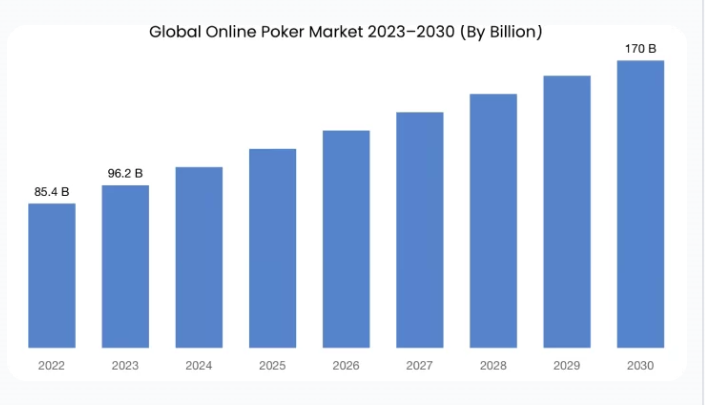Introduction to Poker Game Development
Poker has been a favorite since the beginning of time with its mixture of strategy, skill and chance. Recent years have seen the internet has changed the game of poker and has given players the chance to experience the excitement of playing at any time, from anywhere.
Behind every successful game of poker is a meticulous method of development that blends the technical know-how with creativity to create immersive and exciting gaming.
Understanding the Appeal of Poker Games
Before we get into the complexities of the development of a poker game it is essential to understand the reason why poker is still awe-inspiring to millions of players across the globe.
Poker is a game of strategy and psyche, in which players have to think about information and make logical decisions and be able to outwit their opponents.
The dynamic combination of strategy and luck creates an exciting experience that transcends borders of cultures and is a great choice for players from all backgrounds and ages.
The Rise of Digital Poker Gaming
The development of technology that is digital has brought into a new age of poker, which offers unprecedented accessibility and ease. From mobile applications to online platforms players are now able to enjoy an array of poker variations, ranging across Texas Hold’em to Omaha, available to them.
The shift towards digital gaming has revolutionised the game, allowing players to compete against others across the world and take part in tournaments with different levels of stakes as well as formats.
Key Components of Poker Game Development
Development of poker games is a multifaceted procedure that involves a variety of creative and technical elements. The most important thing is that the development of a successful poker game involves:
- Game Development: Crafting intuitive and exciting game mechanics that capture the essence of poker, while providing a seamless experience for players.
- Software Development: Making use of cutting-edge technology and languages for programming to create solid and robust gaming platforms.
- Graphics and Animation: creating stunningly beautiful interfaces and animations to increase the user’s experience and increase their involvement.
- Secure and Fair: Implementing strict security and fairness measures, as well as random number generator (RNG) methods to ensure fairness and integrity in the playing.
- Multiplayer Functions: Integrating real-time multiplayer capabilities to allow seamless interaction between players, and build exciting gaming environments.
Challenges and Considerations
The digitalization of gaming poker has opened new opportunities however, it also brings particular challenges and concerns for developers. This includes:
- Legal and Regulatory Compliance: Navigating the complex world of gaming licensing and regulations for ensuring compliance the applicable laws.
- Marketing Strategies: Implementing effective strategies for monetization, including advertisements, in-app purchases and subscription models to generate revenues while ensuring a pleasant user experience.
- Communities Building: Promoting a lively and welcoming gaming environment by using forums, social features, and tournaments to increase the player’s retention and loyalty.
- Continuous improvement: Committing to ongoing changes and improvements according to player feedback along with market and industry trends, to ensure that the game remains fresh and enjoyable with time.
Poker Game Market Statistics

Overview of poker game development process
Developing a poker game involves several key steps, from conceptualization to deployment. Here’s an overview of the process:
Conceptualization:
- Define the type of poker game you want to develop (Texas Hold’em, Omaha, Seven Card Stud, etc.).
- Consider whether it will be single-player against AI, multiplayer online, or a combination.
- Determine the target platform(s) (desktop, mobile, web).
Design:
- Create wireframes and mockups of the user interface.
- Design the game mechanics, including rules, betting options, and hand rankings.
- Plan the visual and audio elements, considering the theme and atmosphere of the game.
Development:
- Choose a programming language and framework suitable for your target platform.
- Implement the game logic, including card dealing, hand evaluation, and player actions.
- Integrate any necessary third-party tools or APIs for features like multiplayer networking or payment processing.
- Develop the user interface and ensure smooth gameplay experience across different devices.
Testing:
- Conduct thorough testing to identify and fix bugs, ensuring the game functions as intended.
- Test gameplay balance and fairness, particularly for AI opponents.
- Perform compatibility testing on various devices and platforms.
Deployment:
- Prepare the game for release on your chosen platform(s), following the respective guidelines and requirements.
- Set up servers and infrastructure for multiplayer games if applicable.
- Consider marketing strategies to promote the game and attract players.
Post-launch Support:
- Monitor player feedback and address any issues or suggestions for improvement.
- Release updates and patches as needed to enhance gameplay and fix bugs.
- Maintain servers and infrastructure to ensure uninterrupted online play.
Technology Stack: Tools and platforms used
The technology stack for developing a poker game can vary depending on factors like target platform, budget, and specific requirements. Here’s a generalized list of tools and platforms commonly used in poker game development:
Programming Languages:
- Unity: Often used for developing cross-platform games, including 2D and 3D poker games.
- C#: The primary programming language for Unity development.
- HTML5, CSS, JavaScript: For browser-based poker games or hybrid mobile apps using frameworks like Cordova or Ionic.
- Java or Kotlin: For Android native app development.
- Swift: For iOS native app development.
Game Engines:
- Unity: Provides a comprehensive set of tools for game development, including rendering, physics, and animation.
- Unreal Engine: Another popular game engine suitable for developing high-quality 3D poker games.
Networking:
- Photon Unity Networking (PUN): A popular networking solution for Unity games, suitable for implementing multiplayer functionality.
- Mirror: An open-source networking library for Unity, ideal for real-time multiplayer games like poker.
- Node.js with Socket.IO: For server-side networking in browser-based or mobile multiplayer poker games.
Database:
- MySQL, PostgreSQL, SQLite: Relational database systems commonly used for storing player data, game state, and statistics.
- MongoDB: A NoSQL database option for more flexible data storage, suitable for certain types of poker games.
Graphics and UI:
- Adobe Photoshop, Illustrator: For creating graphics, UI elements, and artwork.
- UI frameworks: Such as Unity UI or Unreal Engine’s UMG (Unreal Motion Graphics) for designing and implementing user interfaces.
Audio:
- Digital Audio Workstations (DAWs): Software like FL Studio, Ableton Live, or Logic Pro for creating and editing audio assets.
- Unity or Unreal Engine audio tools: Built-in tools for implementing sound effects and music in the game.
Version Control:
- Git: Version control system for managing source code and collaborating with a team.
- GitHub, GitLab, Bitbucket: Platforms for hosting Git repositories and managing project development.
Deployment:
- Steam, App Store, Google Play Store: Platforms for distributing and monetizing desktop and mobile games.
- Web hosting services: For deploying browser-based poker games.
- Cloud services: Such as AWS, Google Cloud Platform, or Microsoft Azure for hosting game servers and databases.
How long does it take to develop a poker game?
The development timeline for a poker game can vary significantly depending on factors such as the complexity of the game, the size and expertise of the development team, the availability of resources, and the chosen technology stack. Here’s a rough estimate of the time required for each phase of development:
- Pre-production (Conceptualization and Design): This phase typically takes a few weeks to a couple of months, depending on the thoroughness of the planning process and the complexity of the game concept.
- Production (Development): The development phase is the most time-consuming and can range from several months to a year or more, depending on factors like the scope of the game, the intricacy of the game mechanics, the number of platforms supported, and the level of polish desired.
- Testing and Quality Assurance: Testing and QA can take several weeks to a few months, depending on the size of the game and the thoroughness of the testing process. It’s crucial to allocate sufficient time for testing to ensure the game is stable, bug-free, and meets player expectations.
- Deployment and Post-launch Support: Deploying the game to platforms like app stores or online marketplaces typically takes a few weeks, including the submission and approval process. Post-launch support, including addressing player feedback, releasing updates, and maintaining servers, is an ongoing effort that can extend indefinitely.
In total, developing a poker game from start to finish can take anywhere from six months to two years or more, depending on the project’s scope and complexity. It’s essential for developers to carefully plan and manage the development process to ensure timely delivery and a successful launch.


